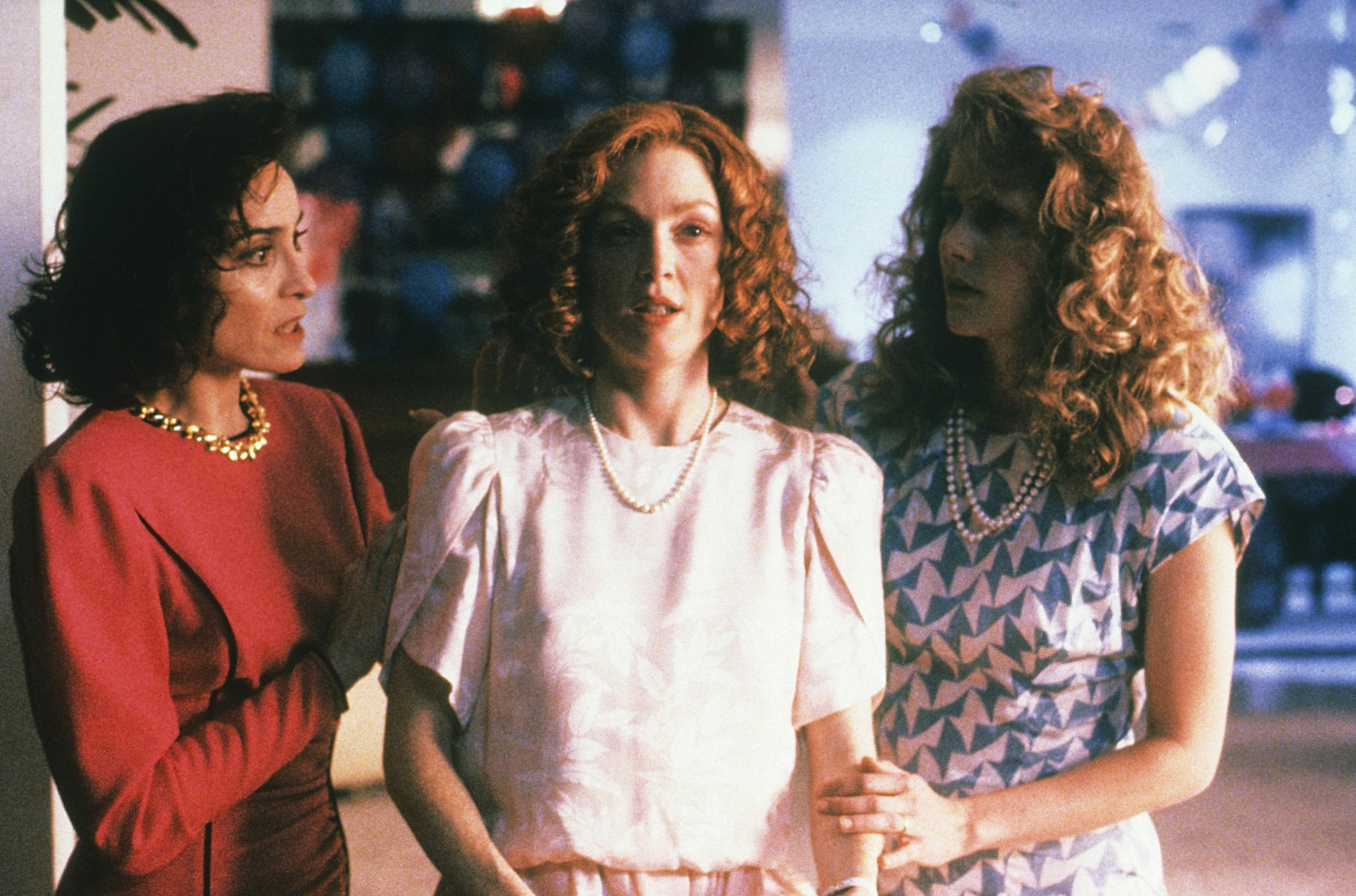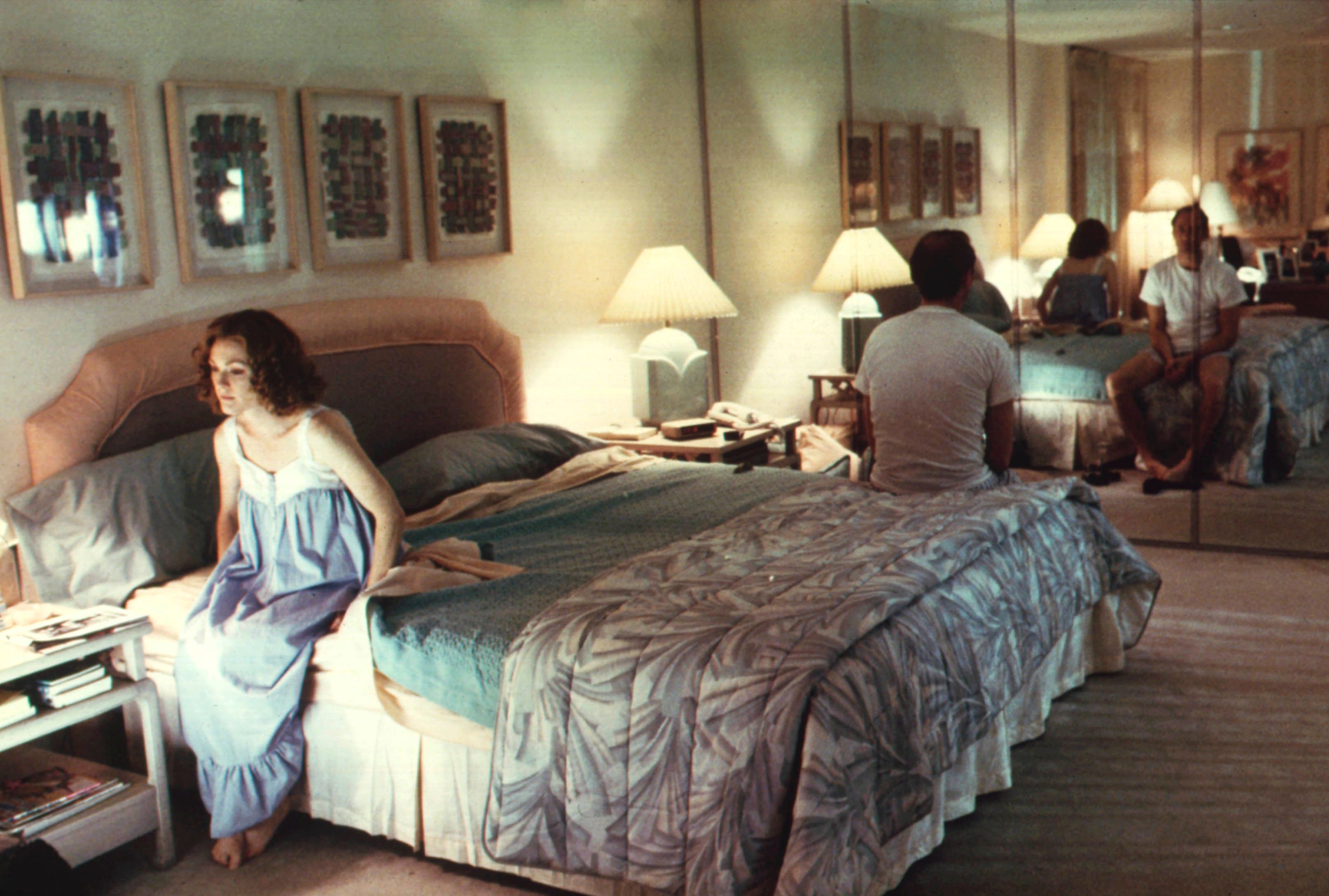The noise is inescapable. In almost every scene of Safe, Todd Haynes’ masterful psychological drama starring Julianne Moore as a mysteriously sick housewife in the late 1980s, there’s something making noise in the background, droning or hissing or whirring. A conversation with a friend is soundtracked by the high-pitched whine of a refrigerator. An al fresco brunch is accompanied by the growling motors and squealing brakes of the adjacent highway. When the radio is on, it’s always just a little too loud, disorienting Carol (Moore) and the audience with weather reports, Christian talk shows, and Billy Ocean. Occasionally, an airplane buzzes overhead, even when Carol tries to cure herself by leaving her home in suburban Los Angeles for a rural New Age retreat. The plane’s ominous drone casts a shadow whenever it appears, reminding the audience of the big, noisy, polluted world that seems to be making Carol so ill.
When Safe was released to critical acclaim in 1995, the mysterious illness that plagues Carol was generally understood as a metaphor for AIDS, which, like the background noise, lingers uneasily throughout the film. Carol and her friend Linda (Susan Norman) talk about the death of Linda’s brother, taking great pains not to say what they both know killed him. (“It wasn’t…?” asks Carol; “No,” replies Linda, unconvincingly. “That’s what everyone keeps [asking]…because he wasn’t married.”) And the toxic positivity of the Wrenwood commune, led by a gay man with AIDS, clearly invokes New Age charlatans like Louise Hay and Marianne Williamson, whose touchy-feely sentiments cloaked ugly, delusional beliefs that AIDS was brought upon by bad thoughts and could be cured with positive thinking. But while Safe is certainly informed by the AIDS crisis, it paints a broader picture of societal malaise that resonates even more strongly today than it did in 1995.
The 1990s saw a number of movies that made use of the suburbs for social commentary: Edward Scissorhands, The Ice Storm, Pleasantville, Happiness, and American Beauty, just to name a few. While they may vary in subject and tone, they all used suburbia to explore the boredom, repression, and bigotry that writhes beneath the surface of the American Dream, like the ant colony beneath a manicured lawn in Blue Velvet. Those movies are all compelling in their own ways, and most of them still hold up today (give or take American Beauty); still, looking back from our bleak, chaotic present, their warnings against the dangers of conformism and ennui seem almost quaint. If those were the most pressing issues our society faced today, there would be celebrations in the street! First-world problems are still problems for somebody, of course, but when a movie’s stuffy suburban milieu looks like a modern post-grad’s most far-flung Zillow fantasy, it’s easy to feel a bit of a disconnect.
There is no such disconnect in Safe. For one thing, Haynes goes out of his way to make Carol’s life seem as unappealing as possible. Her house is enormous, but it’s hard to imagine anyone wanting to actually live there. It’s an inelegant, soulless place straight out of McMansion Hell, each room appearing to have been decorated by separate, yet equally terrible, interior designers. Not once does the house ever feel like a home, and Carol walks through its spacious interiors like she’s lost in a museum after hours. There’s no escapism to be had outside the house, either: Carol’s life is filled with chintzy aerobics classes, awkward conversations, and open-air brunches across the highway from a gas station. Even before she starts getting sick, she seems miserable.
When Carol does start getting sick, Haynes leaves the “how” and “why” purposefully unclear. Her condescending doctor finds nothing wrong with her, and a session with a cold, glowering psychiatrist doesn’t help either. An allergist narrows things down only slightly; when she sees a flyer asking if she’s “allergic to the 20th century,” it seems as good a guess as any. It turns out to be an ad for a multiple chemical sensitivity support group, but whatever the name of her illness, that flyer may be correct. Whether or not fumes or chemicals make her ill, Carol is sickened by the 20th century: by the deodorant of her rich, stone-faced husband (Xander Berkeley), by the perm she gets in a lifeless hair salon, by the traffic on the freeway as apocalyptic Christians chatter on the radio. When Carol starts feeling sick again after joining Wrenwood, it could be, as she says, truck fumes blowing downwind towards her cabin. Or it could be the sickening realization that she fell for a dime-a-dozen huckster, the realization that the people she thought understood her just wanted another smiling face for their brochures.
It’s tempting to look at Safe’s pollution motif as prescient in this era of climate change and microplastics, but it goes much deeper than “pollution is bad.” Safe understands that to live in the modern world is to be disoriented and exhausted, and that the background noise will grow louder until we grow numb to it. It understands that suburbia is just a symptom of a greater illness, and that the kids who wrote essays about dismembered bodies in inner-city Los Angeles are now old enough to run for office. It understands that those who suffer are expected to do so in silence; that there will always be opportunists selling a cure; that there may never be a cure. In short, it understands, better than just about any of its contemporaries, what it’s like to be alive in 2022.
The final scene of Safe, where the background noise finally stops, illustrates this perfectly. After spending the whole film trying to escape her illness, isolating herself from her friends and family in her effort to be “safe,” Carol has finally succeeded – in a way. She is now isolated inside an igloo-shaped cabin, windowless and lined with porcelain to keep all contaminants out. The walls are concrete gray, and the lighting is queasy and fluorescent; it looks like a nuclear bunker more than a home. Carol sits on her bed, breathing through an oxygen mask. It’s eerily quiet; one gets the sense that there is nothing outside this bunker but a white void. Finally, with peace, quiet, and something like health, Carol approaches a mirror and stares at her reflection, repeating her affirmations. “I love you,” she says to herself. “I really love you.” She tries to sound like she means it, and comes up short. Carol is learning a lesson from the future, relatable to anyone who’s tried to unplug: you can escape from the noise and filth and sickness of modern life, but you cannot escape from yourself.
















